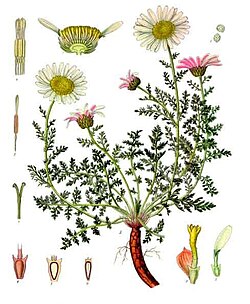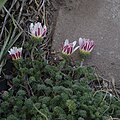| Anacyclus pyrethrum | |
|---|---|
 | |
| Mount Atlas daisy | |
| Scientific classification | |
| Kingdom: | Plantae |
| Clade: | Tracheophytes |
| Clade: | Angiosperms |
| Clade: | Eudicots |
| Clade: | Asterids |
| Order: | Asterales |
| Family: | Asteraceae |
| Genus: | Anacyclus |
| Species: | A. pyrethrum |
| Binomial name | |
| Anacyclus pyrethrum | |
| Synonyms | |
Anthemis pyrethrum L. Contents | |
Anacyclus pyrethrum, the pellitory, Spanish chamomile, Mount Atlas daisy, bertram, or Akarkara, is a species of flowering plant in the daisy family Asteraceae. [4] It is native to Mediterranean Europe and parts of North Africa, but also naturalised in other parts of Europe, India and Pakistan. [5] This herbaceous perennial resembles chamomile species in habitat and appearance.
The plants known as pellitory-of-the-wall and spreading pellitory belong to a different family, the nettles (Urticaceae).



